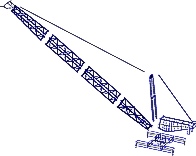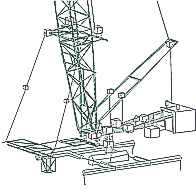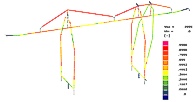Subsystems
Structures can be divided into subsystems, which can be moved and rotated to allow for different operation positions ("situations"). Herewith complex plane kinematic systems can be modelled. In a single calculation model various different situations can be defined and evaluated together.
Proofs of fatigue
KRASTA supports proofs of fatigue according to german, european and international standards. Evaluation method can be classic classification in loading groups or damage accumulation supported by newer standards. The following standards are available:
- AS 4100
- DIN 15018 and DASt 011
- DIN 22261
- FEM 1.001
- EN 13001-3-1
- EN 1993-1-9 (Eurocode 3)
- ISO 5049-1
Mass cases
For the representation of differenciated and changing mass configurations mass cases can be generated. Inertial forces are generated by translational or rotational acceleration. By this means dead load as well as other inertial and centrifugal forces can be generated directly from the mass configuration.
Situation dependen masses and loads
Mass and load cases can be defined situation dependent. For instance hoist load and acceleration can be altered depending on a boom position. Instead of creating an evaluation load pattern for each situation a single evaluation load pattern can be used across all situations.
Multilingual on various levels
KRASTA may be switched between English and German at any time. The language can be set for user interface, result evaluation and help system individually.
Other program characteristics
Except for the specific features mentioned above, KRASTA has usual functions known from other program systems for spatial frameworks, such as interactive modelling, move and copy routines, cross section libraries, evaluation for inner forces and stresses amongst others.



